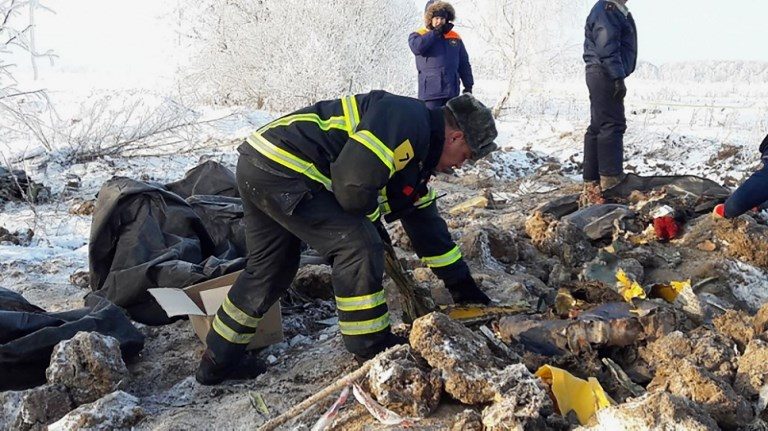SUMMARY
This is AI generated summarization, which may have errors. For context, always refer to the full article.

MOSCOW, Russia – Russian experts investigating the weekend plane crash outside Moscow that killed 71 people said on Tuesday, February 13, that the accident may have been caused by ice on speed-measuring instruments which led to faulty information on the craft’s airspeed.
“A factor in the development of a special situation in the flight could be the wrong data about flight speed on pilots’ indicators which was likely due to iced pitot tubes (speed probes) while their heating systems were shut off,” said the Russian Interstate Aviation Committee (IAC) which investigates aircraft incidents.
The Antonov An-148 plane took off from Moscow’s Domodedovo airport on Sunday to the Russian city of Orsk and went down in a field around 70 kilometers (40 miles) southeast of Moscow shortly after. All 65 passengers and 6 crew members on board died.
The IAC said it has completed analysis of the on-board flight recorder and would still need to analyse the black box which recorded conversations in the cockpit. It would also look at whether the pitot tubes, a vital piece of equipment which measures airspeed, could have malfunctioned.
Iced-over pitot tube instruments were previously named as the likely reason behind the Air France 447 flight crashing into the Atlantic in 2009, killing 228 people on board.
The RBK newspaper on Tuesday quoted sources as saying that the captain of the Russian flight refused the de-icing procedure while the plane was in Domodedovo airport. Kommersant newspaper previously said that this was optional given the relatively mild temperatures at the time.
The IAC said the flight began having problems two and a half minutes after takeoff at an altitude of about 1300 metres (4260 feet), at which point instruments began to display vastly different speeds.
The plane’s autopilot was turned off and it began to sharply lose speed until impact with the ground at 1127 GMT, the IAC said.
Search at crash site
Russia’s Investigative Committee, which probes major crimes, said it would consider the IAC’s findings in its criminal investigation.
Emergency workers have been combing through deep snow at the crash site. On Tuesday, the emergency ministry said they had recovered 1,400 body parts and 900 plane fragments.
Authorities were taking DNA samples from relatives of the victims in order to complete identification.
The emergency ministry added Tuesday that it lifted two engines from a crater formed by the plane’s impact, sending them to be investigated. The search would continue on Wednesday, it said.
The flight was operated by the domestic Saratov Airlines, which announced that it would suspend usage of the An-148.
Russia has suffered numerous plane crashes, with airlines often operating ageing aircraft in dangerous flying conditions.
A light aircraft crashed in November in Russia’s far east, killing six people on board.
In December 2016, a military plane carrying Russia’s famed Red Army Choir crashed after taking off from Sochi, killing all 92 people on board.
Pilot error was blamed for that crash.
In March 2016, all 62 people on board died when a FlyDubai jet crashed in bad weather during an aborted landing at Rostov-on-Don airport. – Rappler.com
Add a comment
How does this make you feel?
There are no comments yet. Add your comment to start the conversation.